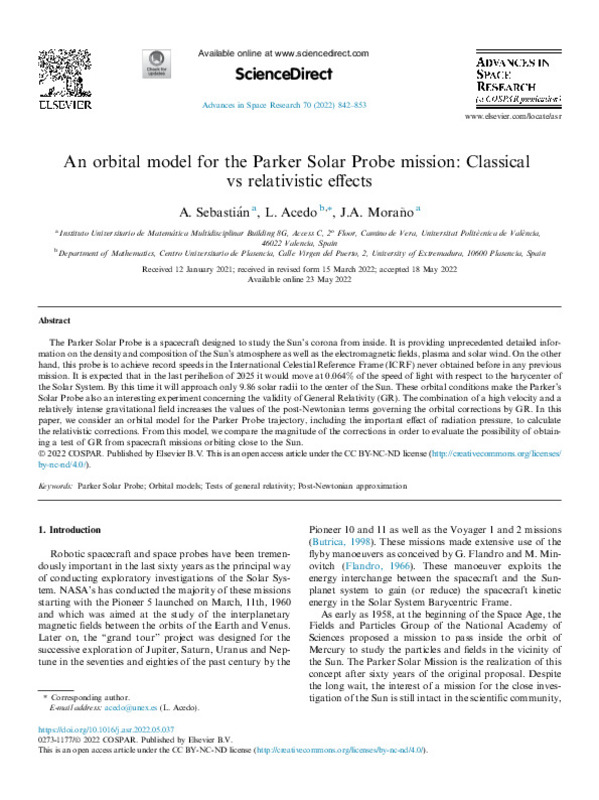JavaScript is disabled for your browser. Some features of this site may not work without it.
Buscar en RiuNet
Listar
Mi cuenta
Estadísticas
Ayuda RiuNet
Admin. UPV
An orbital model for the Parker Solar Probe mission: Classical vs relativistic effects
Mostrar el registro sencillo del ítem
Ficheros en el ítem
| dc.contributor.author | Sebastián, A.
|
es_ES |
| dc.contributor.author | Acedo, L.
|
es_ES |
| dc.contributor.author | Moraño Fernández, José Antonio
|
es_ES |
| dc.date.accessioned | 2023-02-24T19:01:33Z | |
| dc.date.available | 2023-02-24T19:01:33Z | |
| dc.date.issued | 2022-08-01 | es_ES |
| dc.identifier.issn | 0273-1177 | es_ES |
| dc.identifier.uri | http://hdl.handle.net/10251/192078 | |
| dc.description.abstract | [EN] The Parker Solar Probe is a spacecraft designed to study the Sun¿s corona from inside. It is providing unprecedented detailed information on the density and composition of the Sun¿s atmosphere as well as the electromagnetic fields, plasma and solar wind. On the other hand, this probe is to achieve record speeds in the International Celestial Reference Frame (ICRF) never obtained before in any previous mission. It is expected that in the last perihelion of 2025 it would move at 0:064% of the speed of light with respect to the barycenter of the Solar System. By this time it will approach only 9:86 solar radii to the center of the Sun. These orbital conditions make the Parker¿s Solar Probe also an interesting experiment concerning the validity of General Relativity (GR). The combination of a high velocity and a relatively intense gravitational field increases the values of the post-Newtonian terms governing the orbital corrections by GR. In this paper, we consider an orbital model for the Parker Probe trajectory, including the important effect of radiation pressure, to calculate the relativistic corrections. From this model, we compare the magnitude of the corrections in order to evaluate the possibility of obtaining a test of GR from spacecraft missions orbiting close to the Sun. | es_ES |
| dc.language | Inglés | es_ES |
| dc.publisher | Elsevier | es_ES |
| dc.relation.ispartof | Advances in Space Research | es_ES |
| dc.rights | Reconocimiento - No comercial - Sin obra derivada (by-nc-nd) | es_ES |
| dc.subject | Parker Solar Probe | es_ES |
| dc.subject | Orbital models | es_ES |
| dc.subject | Tests of general relativity | es_ES |
| dc.subject | Post-Newtonian approximation | es_ES |
| dc.subject.classification | MATEMATICA APLICADA | es_ES |
| dc.title | An orbital model for the Parker Solar Probe mission: Classical vs relativistic effects | es_ES |
| dc.type | Artículo | es_ES |
| dc.identifier.doi | 10.1016/j.asr.2022.05.037 | es_ES |
| dc.rights.accessRights | Abierto | es_ES |
| dc.contributor.affiliation | Universitat Politècnica de València. Escuela Técnica Superior de Ingeniería del Diseño - Escola Tècnica Superior d'Enginyeria del Disseny | es_ES |
| dc.description.bibliographicCitation | Sebastián, A.; Acedo, L.; Moraño Fernández, JA. (2022). An orbital model for the Parker Solar Probe mission: Classical vs relativistic effects. Advances in Space Research. 70(3):842-853. https://doi.org/10.1016/j.asr.2022.05.037 | es_ES |
| dc.description.accrualMethod | S | es_ES |
| dc.relation.publisherversion | https://doi.org/10.1016/j.asr.2022.05.037 | es_ES |
| dc.description.upvformatpinicio | 842 | es_ES |
| dc.description.upvformatpfin | 853 | es_ES |
| dc.type.version | info:eu-repo/semantics/publishedVersion | es_ES |
| dc.description.volume | 70 | es_ES |
| dc.description.issue | 3 | es_ES |
| dc.relation.pasarela | S\471595 | es_ES |








